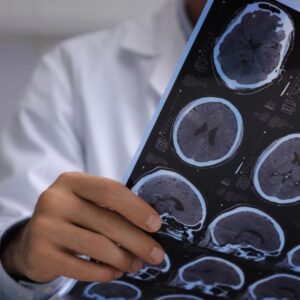Alcohol has a depressive effect on your nervous system, slowing down brain function and the way your nerves send messages back and forth throughout the body.
When you consume large amounts of alcohol for an extended time period, the body starts to adapt to this depressive state by working harder to keep your nerves properly communicating with each other.
If you suddenly stop drinking, the brain needs time to adjust to its normal functioning. This period of recalibrating your nervous system is what causes the physical and emotional symptoms of alcohol withdrawal.Risk Factors for Delirium Tremens
Despite being legal and widely available, alcohol is actually one of the most dangerous drugs to withdraw from. Delirium tremens (DTs) is a term used to refer to the most serious form of alcohol withdrawal. DTs is sometimes called alcohol withdrawal delirium.
Not everyone who experiences alcohol withdrawal will develop DTs. The lifetime risk for developing DTs is estimated to be between 5% and 10% for people who suffer from chronic alcoholism. Risk factors for this type of withdrawal include:
- Heavy alcohol consumption, defined as 4 to 5 pints of wine, 1 pint of hard alcohol, or 7 to 8 pints of beer daily
- Extended history of regular heavy drinking, typically for 10 years or more
- Concurrent medical conditions or poor overall health
- Older age
- Presence of structural brain lesions
- Experience of intense alcohol cravings
- A prior withdrawal experience that included DTs
There is no significant difference in the risk for DTs between genders when alcohol consumption is the same. However, white patients have twice the risk of severe alcohol withdrawal when compared to non-white patients. This is thought to be due to genetic variations in how the body processes alcohol.
Symptoms of DTs
Symptoms of DTs typically begin 2 or 3 days after an alcoholic’s last drink, but can take as long as 7 to 10 days to appear. Most cases last just 24 hours, but severe cases can last for up to 5 days.
Every case is different, but symptoms of DTs may include:
- Nightmares
- Confusion
- Disorientation
- Fever
- High blood pressure
- Heavy sweating
- Rapid heartbeat
- Chest pain
- Fatigue
- Nausea or vomiting
- Severe anxiety, similar to a panic attack
- Visual, auditory, and/or tactile hallucinations
- Uncontrollable tremors
- Seizures
DTs can be fatal without treatment, due to the increased risk of developing respiratory arrest, aspiration pneumonitis, or cardiac arrhythmias. Without treatment, mortality rates are between 15% and 40%.
Although DTs are most strongly associated with alcohol, certain other drugs can create similar risks. Someone who tries to quit barbiturate or benzodiazepine tranquilizers abruptly after extended use is at risk of experiencing DTs.
DTs are different from alcoholic hallucinosis, which is a relatively rare alcohol-induced psychotic disorder developed as a complication of withdrawal. Both conditions are most common in long term alcohol abusers, but alcoholic hallucinosis is a less serious diagnosis than DTs and is not potentially fatal.
Treatment
Someone who is at risk for developing DTs needs to be closely monitored for their own comfort and safety. It can be extremely dangerous for a high-risk alcoholic to attempt withdrawal at home.
Treatment for DTs typically includes:
- Sedation to suppress the excitability of the nervous system, thus reducing the severity of symptoms
- Thiamine and other vitamins to promote proper nutrition
- IV fluids to prevent dehydration
- Dextrose to prevent hypoglycemia
- Monitoring and replacement of electrolytes as necessary, since people suffering from alcoholism often have low calcium, magnesium, phosphorous, or potassium levels
- Treatment of any co-occurring health conditions, such as alcoholic neuropathy, alcoholic cardiomyopathy, Wernicke-Korsakoff syndrome, or alcoholic liver disease
Providing a calm, quiet environment with supportive assurance from medical staff helps keep the patient comfortable throughout the withdrawal process. The physical symptoms of DTs can be very frightening, so addressing a patient’s emotional needs is just as valuable as providing medical care.
Once the withdrawal process is complete, the patient can begin receiving therapy to help maintain sobriety. This can include group, individual, and family counseling as well as participation in alternative therapies such as art therapy, equine therapy, and yoga to promote positive coping skills for a sober lifestyle.
Although being at risk for developing DTs can be scary, it’s important to consider that not seeking treatment for chronic alcoholism is a risky endeavor in itself. Long term alcohol abuse can cause problems with your career, family, and personal relationships as well as an increased risk of cancer, mental illness, cardiovascular disease, liver disease, and cognitive deficits. The sooner you seek help, the sooner you’ll be on your way to a brighter future.

Sources used:
Delirium tremens. MedlinePlus
Delirium Tremens (DTs). Medscape.
Delirium Tremens. The New York Times.
Alcohol Withdrawal Delirium. Healthline.





